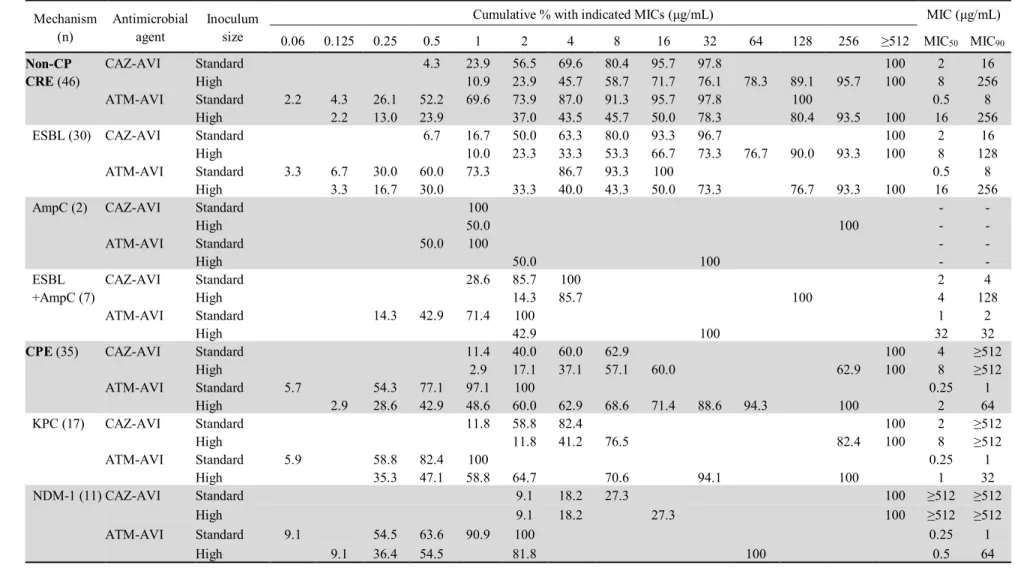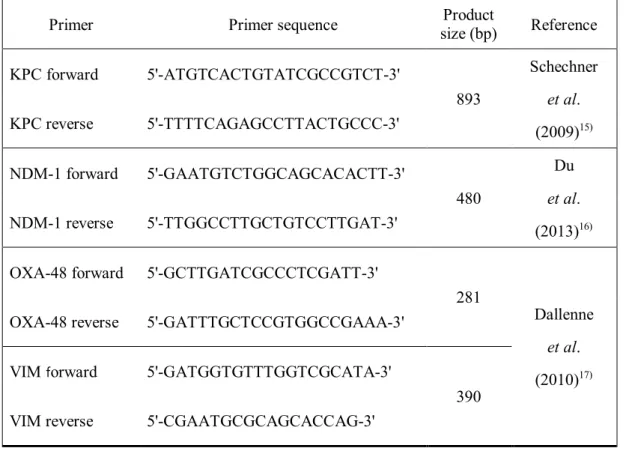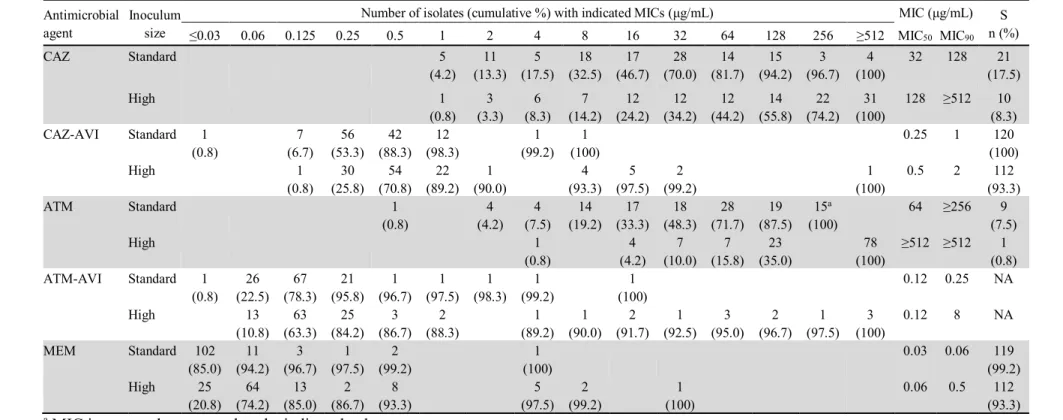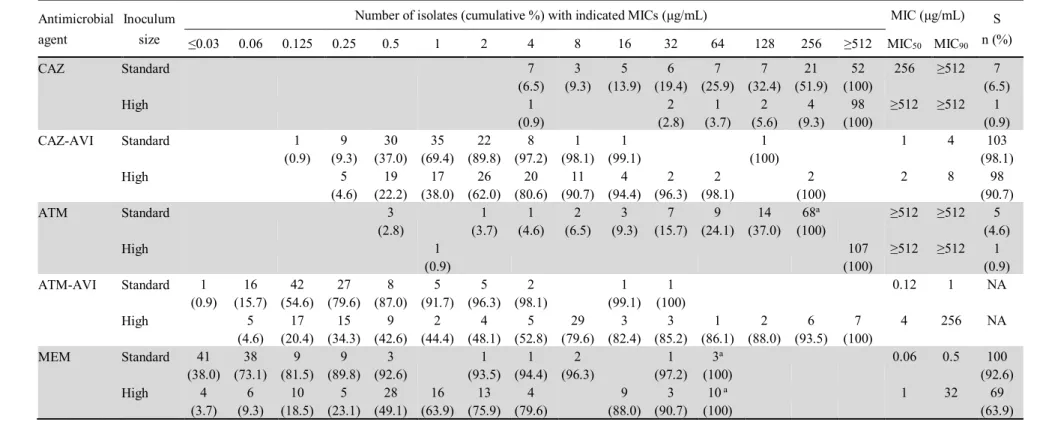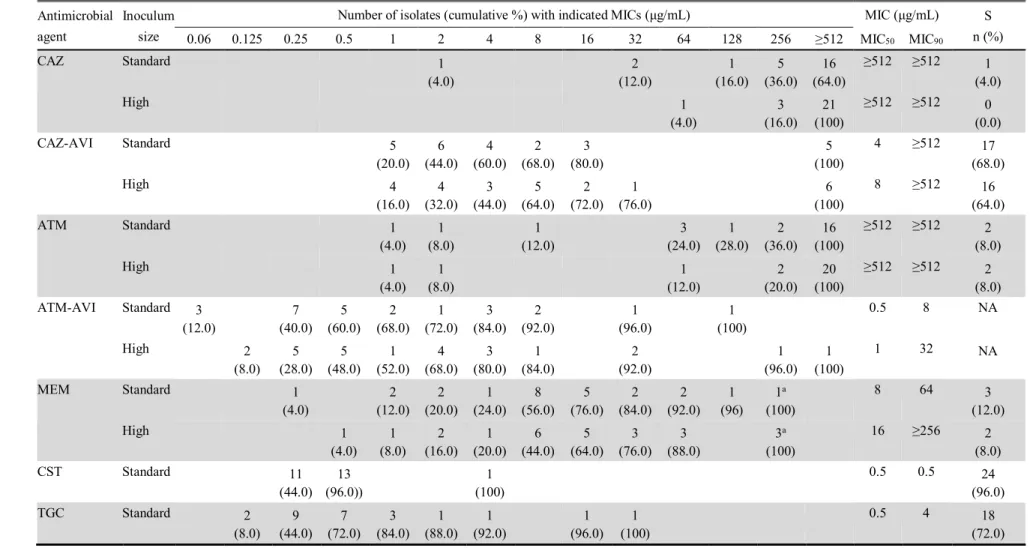다제내성 Klebsiella pneumoniae 와 Escherichia coli 에 다다 ceftazidime-avibactam과 aztreonam-avibactam의. My study aimed to evaluate the in vitro activity of ceftazidime-avibactam and aztreonam-avibactam and their inoculum effect in multidrug-resistant (MDR) Enterobacteriaceae, including carbapenem-resistant Enterobacteriaceae (CRE). Ceftazidime-avibactam and aztreonam-avibactam showed excellent in vitro activity against study blood isolates; MIC50/MIC90 were 0.5/2 μg/mL and 0.125/0.5 μg/mL, respectively.
Ceftazidime-avibactam and aztreonam-avibactam showed relatively good susceptibilities in 81 CRE isolates; 73% of CRE isolates were susceptible to ceftazidime-avibactam and 95% of isolates had aztreonam-avibactam MICs of ≤8 µg/mL. Positive inoculation effect rates for ceftazidime-avibactam and aztreonam-avibactam were 18% and 47%, respectively. -avibactam was more active in vitro against β-lactam-resistant and extended-spectrum CRE isolates than ceftazidime-avibactam.
However, due to its significant inoculum effect in CRE, a possibility of aztreonam-avibactam treatment failure should be considered in high inoculum infection. Aztreonam-avibactam may thus have an advantage over ceftazidime-avibactam in the treatment against MBL-producing strains. However, there are limited data on the susceptibility of aztreonam-avibactam to MDR pathogens or CRE.
My study aimed to evaluate in vitro activity of ceftazidime-avibactam and aztreonam-avibactam and their inoculum effect in MDR Enterobacteriacea, including CRE.
Bacterial isolates
Antibiotic susceptibility test and resistance investigation
Isolates were confirmed for the presence of ESBL with the MicroScan ESBL detection test (including Neg Combo Panel Type 72) using cefotaxime and ceftazidime alone and in combination with clavulanic acid. For isolates in which the presence of ESBL was not confirmed by the ESBL MicroScan detection test, further two-disc synergy test using cefotaxime (30 μg), ceftazidime (30 μg), cefepime (30 μg) and amoxicillin plus clavulanate (20 μg). and 10 μg each) was performed11, 12). The isolates, non-susceptible to cefoxitin (MIC > . 8 μg/mL), were considered as a surrogate marker for the presence of high-level AmpC production and were further characterized by the confirmatory AmpC test using cefoxitin and cloxacillin13).
Cefepime, ceftazidime, cefotaxime and amoxicillin-clavulanic acid disc were purchased from Bio-Rad (Hercules, CA, USA), and cefoxitin disc was obtained commercially from Oxoid (Basingstoke, UK).
Determination of inoculum effect
All 228 study blood isolates were resistant to cefotaxime on the MicroScan panel; 26 (11%) isolates were carbapenem nonsusceptible and only three (1%) were carbapenemase-producing Enterobacteriaceae (CPE) in K. However, ceftazidime-avibactam and aztreonam-avibactam showed good in vitro activity against the study blood isolate; . Ninety-nine percent of isolates were susceptible (MIC≤ 8 μg/mL) to ceftazidime-avibactam, and when the aztreonam-avibactam susceptibility cutoff of 8 μg/mL was used, 99% of isolates were susceptible to aztreonam-avibactam.
Therefore, 8% and 21% of isolates became resistant to ceftazidime-avibactam and meropenem, respectively, at high inoculations; 15% of isolates were aztreonam-avibactam MICs of ≥16 μg/mL. Positive inoculation effect rates for ceftazidime-avibactam, aztreonam-avibactam, and meropenem were 22%, 30%, and 38%, respectively. Positive inoculation effect rates for extended-spectrum β-lactam-resistant isolates Number of isolates (%) positive inoculation effect.

Susceptibility and inoculum effect according to resistance type in 81 CRE isolates The MIC distributions in CRE against ceftazidime-avibactam and aztreonam-avibactam.
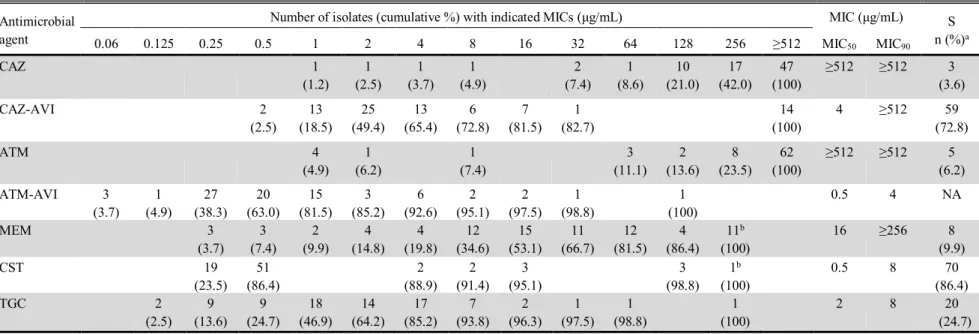
Susceptibility and inoculum effect according to resistance type in 81 CRE isolates The MIC distributions in CRE against ceftazidime-avibactam and aztreonam-avibactam
Most extended-spectrum β-lactam-resistant and carbapenem-resistant isolates were susceptible to ceftazidime-avibactam. These results indicate that ceftazidime-avibactam can effectively inhibit β-lactam-resistant extended-spectrum isolates and that the antimicrobial activity of ceftazidime-avibactam is as effective as meropenem. However, ceftazidime-avibactam did not inhibit some carbapenem-resistant isolates, most of which were CPE isolates, including isolates expressing NDM-1.
In this study, ceftazidime-avibactam did not inhibit class B metallo-β-lactamase such as NDM-1 (MIC: ≥512 μg/mL), similar to previous studies 8 , 21 ). The reason for setting the provisional breakpoint for aztreonam-avibactam at 8 μg/mL was that ceftazidime-avibactam is administered at 2 g q8t of the ceftazidime component, resulting in a higher breakpoint (8 μg/mL) than ceftazidime alone; breaking point determined at 1 g q8t. The breakpoint for aztreonam-avibactam can be set to 8 μg/ml, as with ceftazidime-avibactam, if it is determined that the aztreonam component is to be administered at 2 g every 8 hours.
When the breakpoint of aztreonam-avibactam was considered to be 8 mg/ml, 99% of all β-lactam-resistant isolates with extended spectrum were susceptible and 95% of carbapenem-resistant isolates were susceptible to aztreonam-avibactam. This result suggested that aztreonam avibactam has a higher antimicrobial activity than ceftazidime avibactam against CRE and that it was comparable to colistin. In the current study, I observed changes in the MICs of ceftazidime avibactam and aztreonam avibactam depending on inoculum size.
These data suggest that aztreonam-avibactam is more affected by inoculum size than ceftazidime-avibactam in K. In conclusion, ceftazidime-avibactam was a reasonable choice to overcome extended-spectrum β-lactam-resistant isolates; however, it had weak activity against CRE, especially against CPE. Aztreonam-avibactam was more active in vitro against extended-spectrum β-lactam-resistant and CRE isolates than ceftazidime-avibactam.
CP-CRE/non-CP-CRE Stratification and CRE Resistance Mechanism Determination Help Better Manage CRE Bacteremia Using Ceftazidime-Avibactam and Aztreonam-Avibactam. Comparison of antimicrobial activity between ceftolozane-tazobactam and ceftazidime-avibactam against multidrug-resistant isolates of Escherichia coli, Klebsiella pneumoniae and Pseudomonas aeruginosa. Antimicrobial activity of Ceftazidime-Aibactam against Gram-negative bacteria isolated from patients hospitalized with pneumonia in the USA.
2012년부터 2015년까지 40개국 임상 실험실에서 분리된 Enterobacteriaceae 및 Pseudomonas aeruginosa에 대한 Aztreonam-Avibactam의 in vitro 활성. 또한 ceftazidime-avibactam 및 aztreonam-aeruginosa의 in vitro 활성을 βruga-avibact 시리즈로 평가했습니다. - 내성 장내 세균 항생제 내성 메커니즘이 분류되고 평가되었습니다.
